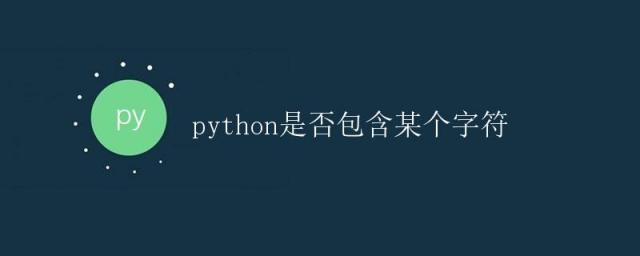Python是否包含某个字符
2024年04月19日 Python是否包含某个字符 极客笔记
Python是否包含某个字符

在Python中,我们经常需要判断一个字符串是否包含某个特定的字符或子串。这种需求在实际开发中非常常见,比如验证用户输入是否符合格式要求、查找特定关键字等。本文将详细介绍在Python中如何判断一个字符串是否包含某个字符。
使用in关键字判断字符是否在字符串中
Python中可以使用关键字in来判断一个字符是否在字符串中,其语法如下:
char in string
其中char为待查找的字符,string为待查找的字符串。如果char在string中,返回True;反之,返回False。
下面我们来看一个简单的示例:
text = "Hello, World!"
if "o" in text:
print("The character 'o' is in the string")
else:
print("The character 'o' is not in the string")
运行结果为:
The character 'o' is in the string
通过使用in关键字,我们可以方便地判断一个字符是否在给定的字符串中。
使用count()方法统计字符出现次数
除了判断一个字符是否在字符串中,有时候我们还需要知道该字符在字符串中出现的次数。Python中的字符串对象提供了count()方法来完成这个任务。
count()方法的语法如下:
string.count(char)
其中char为待统计出现次数的字符,string为待查找的字符串。count()方法会返回char在string中出现的次数。
下面我们来看一个示例:
text = "Hello, World!"
count_o = text.count("o")
print(f"The character 'o' appears {count_o} times in the string")
运行结果为:
The character 'o' appears 2 times in the string
通过使用count()方法,我们可以方便地统计一个字符在字符串中出现的次数。
使用find()方法找到字符首次出现位置
有时候我们不仅仅需要知道一个字符在字符串中是否出现,还需要知道它首次出现的位置。Python中的字符串对象提供了find()方法来找到字符在字符串中首次出现的位置。
find()方法的语法如下:
string.find(char)
其中char为待查找的字符,string为待查找的字符串。find()方法会返回char在string中首次出现的位置的索引,如果没有找到则返回-1。
下面我们来看一个示例:
text = "Hello, World!"
index_o = text.find("o")
if index_o != -1:
print(f"The character 'o' first appears at index {index_o}")
else:
print("The character 'o' is not in the string")
运行结果为:
The character 'o' first appears at index 4
通过使用find()方法,我们可以找到一个字符在字符串中首次出现的位置。
使用index()方法找到字符首次出现的索引
与find()方法类似,Python中的字符串对象还提供了index()方法来找到字符在字符串中首次出现的索引。
index()方法的语法如下:
string.index(char)
其中char为待查找的字符,string为待查找的字符串。index()方法会返回char在string中首次出现的位置的索引,如果没有找到则会抛出ValueError异常。
下面我们来看一个示例:
text = "Hello, World!"
try:
index_o = text.index("o")
print(f"The character 'o' first appears at index {index_o}")
except ValueError:
print("The character 'o' is not in the string")
运行结果为:
The character 'o' first appears at index 4
与find()方法不同的是,index()方法在没有找到字符的情况下不会返回-1,而是抛出异常。
使用startswith()和endswith()方法判断字符串开始和结束字符
有时候我们并不关心一个字符在字符串中的具体位置,而只是想知道字符串是否以某个特定的字符开始或结束。Python中的字符串对象提供了startswith()和endswith()方法来完成这个判断。
startswith()方法的语法如下:
string.startswith(prefix)
其中prefix为待判断的起始字符,string为待判断的字符串。如果string以prefix开头,则返回True;反之返回False。
endswith()方法的语法如下:
string.endswith(suffix)
其中suffix为待判断的结尾字符,string为待判断的字符串。如果string以suffix结尾,则返回True;反之返回False。
下面我们来看一些示例:
text = "Hello, World!"
if text.startswith("H"):
print("The string starts with 'H'")
else:
print("The string does not start with 'H'")
if text.endswith("!"):
print("The string ends with '!'")
else:
print("The string does not end with '!'")
运行结果为:
The string starts with 'H'
The string ends with '!'
通过使用startswith()和endswith()方法,我们可以方便地判断一个字符串是否以某个特定的起始字符或结尾字符开始或结束。
使用正则表达式匹配字符
在处理复杂的匹配需求时,我们可以使用Python中的正则表达式库re来完成。正则表达式提供了强大的模式匹配功能,可以用于查找、替换、分割等操作。下面我们来看一个简单的示例,使用正则表达式来判断一个字符是否在字符串中:
import re
text = "Hello, World!"
pattern = r"o"
if re.search(pattern, text):
print("The character 'o' is in the string")
else:
print("The character 'o' is not in the string")
运行结果为:
The character 'o' is in the string
通过使用正则表达式,我们可以灵活地处理各种复杂的字符匹配需求。
总结
在Python中判断一个字符是否在字符串中有很多种方法,我们可以使用简单的in关键字来判断,也可以使用count()方法统计字符出现次数,或者使用find()、index()方法找到字符首次出现位置。此外,还可以使用startswith()和endswith()方法来判断字符串起始或结尾的字符。在处理复杂的匹配需求时,可以借助正则表达式来实现更灵活的字符匹配操作。无论是简单还是复杂的场景,Python提供了丰富的工具和库来满足我们的需求。
本文链接:http://so.lmcjl.com/news/2557/